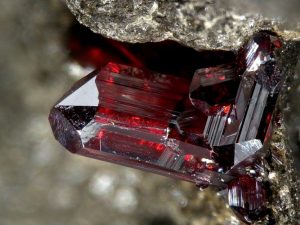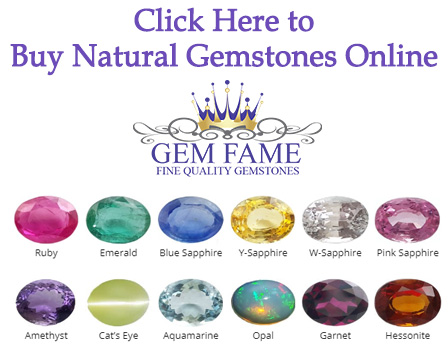Proustite
Proustite is a rare member of the Proustite Group of minerals that also includes Pyrargyrite. Both minerals are ofter referred to by the nickname “Ruby Silver” because of their deep red color and silver content. The chemical formula of Proustite is Ag3AsS3 (Silver Arsenic Sulfide) and its molecular weight is 494.72 gm. Proustite is a silver arsenic sulfide and Pyrargyrite is a silver antimony sulfide. The two are isostructural which means the two minerals have the same structure but a different chemistry. Proustite has a specific gravity of 5.57 (g/cm3) and the refractive index of 2.792 – 3.088 Uniaxial ( – ). Proustite is rarer than Pyrargyrite espessially when it comes to faceted gems. Proustite gems are almost impossible to find since crystals are usually too small or dark and faceting is very difficult due to its softness. Proustite gems can be very attractive with the deep red color and adamantine luster.
Proustite, as with other silver minerals, is reactive to light and can form a white coating or turn black upon prolonged exposure. The white coating can be wiped off, but the blackening can’t be reversed. Gems and specimens should be stored in the dark with limited light exposure.
Proustite occurs at many localities, but rarely in fine crystals or as an important ore mineral. From Germany, in the Himmelsfürst mine, Erbisdorf, near Freiberg; and at Niederschlema, Saxony. In Romania, at Sacarîmb (Nagyág). From Jáchymov (Joachimsthal) and Príbram, Czech Republic. At Sainte-Marie-aux-Mines, Haut-Rhin, France. From Sarrabus, Sardinia, Italy. In the USA, in Colorado, at Red Mountain, San Juan County, and at Georgetown, Clear Creek County; in Idaho, large masses at the Poorman mine, Silver City district, Owyhee County; in Nevada, in the Star mine, Cherry Creek district, White Pine County In Canada, from the Keeley mine, South Lorrain Township, Ontario. In Chile, at Chañarcillo, south of Copiapó, Atacama, as exceptional crystals. From Mexico, at Batopilas, Chihuahua, and Sombrerete, Zacatecas.
| Chemical Formula: | Ag3AsS3 |
| Silver Arsenic Sulfide | |
| Molecular Weight: | 494.72 gm |
| Composition: | Silver | 65.41 % | Ag | ||
| Arsenic | 15.14 % | As | |||
| Sulfur | 19.44 % | S | |||
| 100.00 % |
| Crystallography: | Trigonal – Hexagonal Scalenohedral | |
| Crystal Habit: | Crystals prismatic, to 8 cm; commonly rhombohedral with dominant {0112} or {1011}; also scalenohedral with prominent {1231}; massive, compact. | |
| Twinning: | On {1014} to produce trillings; also common on {1011} and on {0001}, {0112}. | |
| Cleavage: | Distinct on {1011} |
| Fracture: | Conchoidal to Uneven |
| Tenacity: | Brittle |
| Moh’s Hardness: | 2.0 – 2.5; VHN = 70–105 (25 g load) |
| Density: | 5.57 (g/cm3) |
| Luminescence: | None |
| Radioactivity: | Not Radioactive |
| Other: | Exposure to light causes Proustite to turn black. This is a photochromic effect due to the presence of silver. So Proustite should not be displayed in strong light. |
| Color: | Scarlet, Vermilion or Reddish Gray |
| Transparency: | Translucent to Transparent (rarely); darkens with exposure to light |
| Luster: | Adamantine to Submetallic |
| Refractive Index: | 2.792 – 3.088 Uniaxial ( – ) |
| Birefringence: | 0.295 – 0.296 |
| Dispersion: | Very high |
| Pleochroism: | Moderate; cochineal-red to blood-red |
| Anisotrophism: | Strong |


